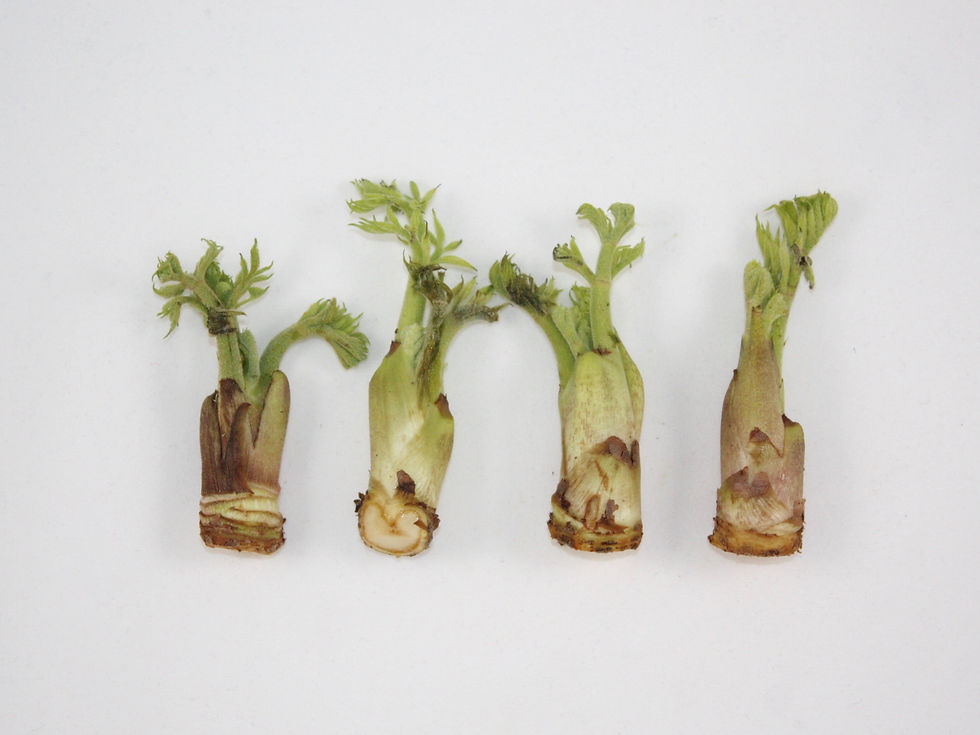What's in season?....Spring mountain vegetables!

In Japan, when sansai (山菜) or mountain vegetables appear in markets and on menus, it is a sign that spring is near. Sansai include the edible buds and shoots of plants that grow naturally in the wild and are foraged as the snows melt. Although the word ‘sansai' refers to wild vegetables, some have been successfully cultivated and are now farm grown. Sansai often appear in early spring menus in simmered and rice dishes. Although it is said that they are best served as tempura as the oil softens the bitterness common to these vegetables.

Fuki no tō (ふきのとう 蕗の薹)
Fuki no tō or butterbur sprouts are an early spring delicacy. They are the buds of the Fuki plant. They push their way up through the snow in the mountains and signal the coming of the spring season. The most familiar way to serve fuki-no tō is as tempura. The sprouts are prepared by removing the outer layer and tough part of the base; then the remaining outer layers are slowly opened up to form a 'flower' as shown. The vegetable is then dipped into the tempura batter by holding the base of the sprout in order to retain its shape, before frying.
However, the farmer from whom we purchased our sprouts recommended that we make fuki-miso paste. To make this, simply sautée finely chopped butterbur sprouts and then mix in some miso paste. The fuki-miso paste is then eaten thinly spread over a hot bowl of rice.
Fuki no tō may also be eaten after boiling for around five minutes as this process removes the harsh taste of the vegetable. The sprouts can then be enjoyed with soy sauce and bonito flakes or with just mayonnaise. For a more Western-style taste, the butterbur sprouts can be sautéed in olive oil and garlic before adding a sprinkle of salt.

Urui (うるい)
Urui are commonly known as Hostas, Ginbo, Oobagiboshi or Hosta Montana. The vegetable has a simple taste similar to asparagus. Although it is a wild vegetable, most of the urui found in Japanese supermarkets are now grown in greenhouses. They have a long white stem and small, soft yellow-green leaves, which are all edible. Urui can be eaten raw in salads, boiled, stir-fried or made into tempura. Upon cooking, urui can take on a slimy texture.
We like to eat urui cut into matchsticks with an assortment of other vegetables (cucumber, carrot and daikon) and a mayo-miso dip.

Tara no me (たらのめ たらの芽)
Tara no me are the new leaf shoots of the Japanese Angelica tree and are popularly known as the king of sansai. It is one of the more bitter mountain vegetables and therefore the Japanese almost always use it to make tempura. It can also be eaten after it has been boiled or soaked in water as this removes the astringency of the vegetable.
Before cooking tara no me, the tough base and the outer layers on the bottom half of the vegetable should be removed.

Kogomi (こごみ 屈)
Kogomi or Ostrich Fern Fiddleheads are easily recognisable by their tightly curled young tips. As a rule of thumb they should be blanched or cooked before consumption so as to remove some of their bitterness and to make them easier to digest. Kogomi have a similar taste to asparagus and are prepared in a similar way by cutting of the hardened bottom of the stems before they are cooked.
Kogomi can be cooked in simmered and sautéed dishes, added to dressed salads and fried into tempura. Our favourite way to serve blanched kogomi is with a sesame dressing or sautéed with butter, garlic, parsley and then seasoned with salt and pepper.
Happy dining!
If you are interested in learning more about the fresh produce sold in Japanese supermarkets, then check out our Guide to Buying Fresh Groceries.














